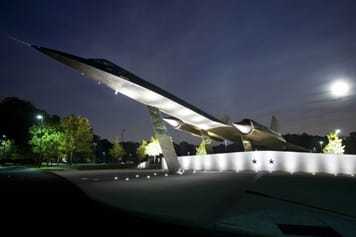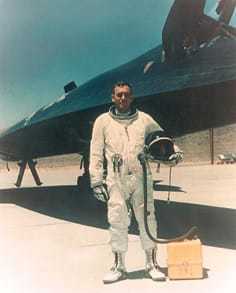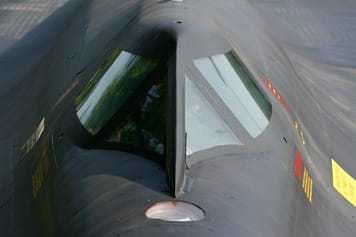About the A-12 OXCART
CIA developed the highly secret A-12 OXCART as the U-2 spy plane’s successor, intended to meet the nation’s need for a very fast, very high-flying reconnaissance aircraft that could avoid Soviet air defenses. CIA awarded the OXCART contract to Lockheed (builder of the U-2) in 1959. In meeting the A-12’s extreme speed and altitude requirements, Lockheed–led by legendary engineer Clarence “Kelly” Johnson–overcame numerous technical challenges with cutting-edge innovations in titanium fabrication, lubricants, jet engines, fuel, navigation, flight control, electronic countermeasures, radar stealthiness, and pilot life-support systems. In 1965, after hundreds of hours flown at high personal risk by the elite team of CIA and Lockheed test pilots, the A-12 was declared fully operational, attaining the design specifications of a sustained speed of Mach 3.2 at 90,000 feet altitude.

Despite only flying during one reconnaissance operation, the A-12 OXCART symbolized innovation during the Cold War.
CIA’s operational use of the A-12 was beset by not only many technical problems but also political sensitivity to aircraft flights over denied areas and competition from imaging satellites. After the U-2 piloted by Francis Gary Powers was shot down over the Soviet Union in May 1960, all USSR overflights were halted, thus blocking the A-12’s original mission to monitor the Soviet Bloc. By the time of CIA’s first A-12 deployment in 1967, CORONA satellites were being launched regularly to collect thousands of images worldwide each year. Although its imagery was less timely and of poorer resolution than the A-12’s, CORONA was invulnerable to anti-aircraft missiles and much less provocative than A-12 overflights. At the same time, the US Air Force was developing the SR-71, a modified version of the A-12. Seeing little value in maintaining both overt SR-71 and covert A-12 fleets with similar capabilities, President Johnson ordered retirement of the A-12 in 1968.

A-12 full pressure suits’ sleeves provided emergency instructions for pilots to use upon ejection.
The only A-12 reconnaissance operation, codenamed BLACK SHIELD, took place from May 1967 to May 1968. A detachment of six pilots and three A-12s based at Kadena Air Base in Okinawa flew 29 missions over East Asia. The panoramic stereo camera aboard each aircraft yielded considerable high-quality imagery that within hours of landing was processed and under the eyes of photointerpreters, who extracted key intelligence information in support of US military operations during the Vietnam War.
CIA’s A-12 represents a pioneering achievement in aeronautical engineering and, to this day, holds records for speed and altitude (Mach 3.29 at 90,000 feet) for an air-breathing piloted jet aircraft.
In 2007 the US Air Force transferred an A-12 to CIA for display. CIA Museum’s A-12 is the eighth of 15 built under the OXCART Program and one of nine remaining. It is known as Article 128, with a serial number of 60-6931. Its first flight was on 3 October 1963, and it was the first of the operational fleet to be certified to fly at Mach 3. During its lifetime, it logged 453 hours on 232 test and training flights. The airframe was retired on 28 May 1968.
“The A-12 is the pride of the CIA and everyone associated with it, as it should be. You should be proud that the A-12 can be installed in Langley. We risked our lives and careers daily for the success of the A-12. It was an amazing success due greatly to the CIA management.”
(A-12 Test Pilot, "Dutch 21"; SR-71 Test Pilot and Instructor Pilot)
Colonel Ken Collins, USAF, Ret.

Frank Murray, an A-12 Pilot, in a S-901 Pressure Suit.
Article 128 arrived at CIA Headquarters on 9 August 2007 aboard five wide-load trucks. A crew of five assembled the airframe in 10 days, and its official presentation took place on 19 September 2007, as part of CIA’s 60th anniversary celebration.
On 8 December 2007, Article 128 “flew” for the last time when two enormous cranes lifted the 39,000-pound airframe onto its three-pylon mount. The pylons hold the airframe in an operational flight attitude at 85,000-90,000 feet–its nose up 8 degrees and airframe rolled 9 degrees to the left. Engineering specifications insure that the airframe as mounted could withstand winds of up to 130 mph. As a result, the pylons extend almost 40 feet below the surface where they are anchored into concrete footings.

A-12 pilots had to be less than six feet tall and under 175 pounds so they could fit in the A-12’s cramped cockpit.
CIA’s Facilities Support completed the display in early May 2008, 40 years after the OXCART Program ended. The site also commemorates two CIA A-12 pilots, Walt Ray and Jack Weeks, killed in 1967 and 1968, respectively. For the CIA workforce, the A-12 is a symbol of the successful collaboration of the Intelligence Community, the Defense Department, and private industry to create a national strategic asset that our adversaries never dreamed possible.
Videos
The Debrief: Behind The Artifact - A-12 OXCART
Soviet radar picked up the CIA’s U-2 photo reconnaissance first over flight.
So the CIA knew early on that we needed to fly higher and faster. Codenamed OXCART, the A-12 was a true feat of aviation technology. Flying at 90,000 feet, which was 20,000 feet higher than it’s older brother, the U-2. And at speeds reaching Mach 3.29, the A-12 was destined to be the fastest plane in the sky.
In the 1950s, the CIA partnered with Lockheed to create the A-12 and development required new technologies. Meeting the desired characteristics led to innovation in things like mechanics, materials, and engine technology. Even creating a plane that could withstand heat at Mach 3.29 was quiet a challenge.
The A-12 took it’s first flight at Area 51 on April 26, 1962 and in May it broke the sound barrier flying at Mach 1.1. In May and August of 1965, it actually set speed and altitude records flying at 90,000 feet and Mach 3.29 – that’s almost 25 hundred miles per hour.
Unfortunately, the CIA lost two pilots flying the A-12, both of whom are on our Memorial Wall here at CIA Headquarters. The CIA and Lockheed built 15 A-12s and three flew operationally over the Southeast part of Asia during the Vietnam War. But, by this point in history CIA had a decision to make. Do we risk pilots being shot down as Soviet and enemy air defense systems improve or do we move fully to photo reconnaissance satellites for our imagery.
The Air Force’s SR-71 Blackbird superseded the A-12,
and in 1968 the CIA A-12 program ceased. The A-12’s last mission was flying over North Korea after they seized the USS Pueblo in 1968.
"Archangel"
This video does not include speaking.
